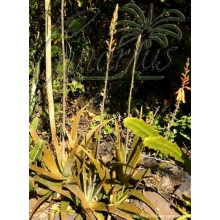Ficus auriculata 'Everest'
This is one of the most ornamental Ficus species. Leaves are huge, rounded, ribbed and velvety., They are bright red when they are new. As an adult, it is a large shrub to small tree, some 2-12 m tall. Figs are edible too and they are truly beautiful, because they grow directly on the trunk with a velvety shine.
Neu
This is one of the most ornamental Ficus species. Leaves are huge, rounded, ribbed and velvety., They are bright red when they are new. As an adult, it is a large shrub to small tree, some 2-12 m tall. Figs are edible too and they are truly beautiful, because they grow directly on the trunk with a velvety shine. It sheds leaves for a short time at the peak of winter or in severe drought. It is grown in Tenerife, at least since when the botanist David Fairchild visited the island in 1903-1935. People call it the Himalayan Fig, but it is chiefly native to moist valleys of southern China at elevations of 100 - 1,700 m. This clone is being marketed as Ficus auriculata 'Everest'. We assume it is just one more commercial name and the plants show little or no difference with the wild material. The fruits are edible and for this reason they are widely collected from the wild and eaten in gardens.
The picture of the fuits is from wikimedia commons: By Vengolis - Own work, CC BY-SA 3.0, https://commons.wikimedia.org/w/index.php?curid=68364987
The picture of the leaves is from wikimedia commons: By കാക്കര - Own work, CC BY-SA 3.0, https://commons.wikimedia.org/w/index.php?curid=19891802
The picture of the fuits is from wikimedia commons: By Vengolis - Own work, CC BY-SA 3.0, https://commons.wikimedia.org/w/index.php?curid=68364987
The picture of the leaves is from wikimedia commons: By കാക്കര - Own work, CC BY-SA 3.0, https://commons.wikimedia.org/w/index.php?curid=19891802
| Anbau | Innenanbau |
| Herkunft der Arten | Asien |
| Präsentation | Eingetopft in Erde Mischung |
| Maximale Größe | 200cm-400cm |
| Botanische Familie | Moraceae |
| Lichtbedürfnis | Sonne |
| Lichtbedürfnis | Durchschnittliches Licht |
| Mindesttemperatur im Winter | 0 ºC bis 10 ºC |
| Mindesttemperatur im Winter | -5 ºC bis 5 ºC |
| Pflanzentyp | verholzend |
| Farbe | Grün |
| Pflegebedürfnis | Zimmerpflanzen |
| Pflegebedürfnis | Blumentopf |
| Wuchsform | Bäume |






















